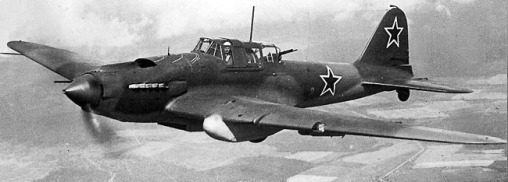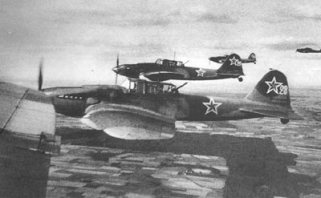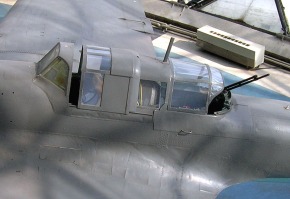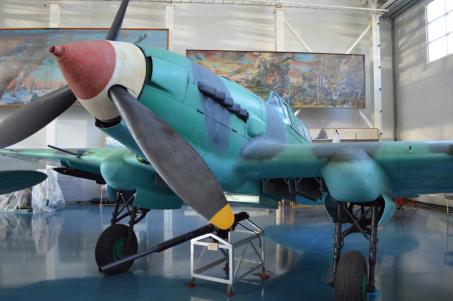
An Ilyushin Il-2 in flight. Public domain.
The Ilyushin Il-2 Sturmovik rightfully has its place as one of the most decisive weapons in the Soviet Union’s victory over Germany on the Eastern Front during World War Two. In nearly all major Soviet offensives, the “flying tanks” provided crucial close air support to the Red Army infantry on the ground. Like much of the Soviet military, however, the effective tactics that the German Wehrmacht would eventually grow to fear evolved through a series of trials and often times disastrous errors, and it was not until the Battle of Kursk in 1943, when Il-2 squadrons adopted the closed loop tactic, that the Sturmoviks became a decisive force on the battlefield. Indeed, the Sturmovik formations providing close air support at the Battle of Kursk were as instrumental in the Soviet victory as any other part of the Red Army.
In the early months of the war, Sturmovik tactics involved approaching a target in groups of 3-5 aircraft, attacking one at a time from an altitude of 20 meters up to 200 meters. Each Il-2 would expend all of its ammunition and ordinance over the target in a single pass. Such tactics meant each Sturmovik received little to no cover from the other aircraft in their formation. What is more, Ilyushin had yet to manufacture two-seat Il-2s with a rear gunner at this time, making the Sturmoviks easy prey for Luftwaffe pilots in 1941. Indeed, in the early stages of the war, on average, one Il-2 was lost for every nine combat sorties.

Il-2s in formation. Photo from Aviapress
Soviet pilots and researchers at the Nauchno-Ispytatelniy Poligon Aviatsionnogo Vooruzheniya (Aviation Armament Scientific Testing Firing Range) quickly determined that Ilyushins had to attack from higher altitude in order to increase battle efficiency. It was also found that three runs over the target were required for each Sturmovik to inflict significant and accurate damage on the ground target. In the first pass, the Il-2 might fire its four rockets, in the second, the Sturmovik could drop its bombs, and the third pass could involve strafing with its combination of machine guns and cannons. Whatever the order, it was determined that the most effective Il-2 attack involved using each type of armament in separate passes. This naturally required significantly more time over the target than the initial tactic of hit and run. In order to provide sufficient cover for each formation, it was determined that circling above the target would allow each Sturmovik to cover the aircraft in front of it while simultaneously allowing time for the optimum three passes over the target.
The closed loop, which was also known as the “circle of death”, involved up to eight Il-2s forming a defensive circle, each aircraft protecting the one ahead of it with its forward machine guns. The aircraft were spaced 150-200 meters apart, at an altitude of at least 300 meters, banking at 15-40 degrees. Each individual Il-2 took turns leaving the circle, attacking the target, and rejoining the circle. Such formations would remain over a ground target for up to 20 minutes, until all ammunition and ordinance was expended, after which time the Il-2s would regroup and return to base. The circle was also used for collective defense against German fighters when attacked before the formation reached the target, as the large field of cover ensured that no individual Sturmovik was vulnerable to attack.
Sturmovik pilot Mikhail Shatilo recalled maintaining the closed loop for up to 20 minutes over a target, saying “sometimes there would be a lot of German pairs flying nearby, but what would they do? If they came too close, we would be covered. The Germans knew not to come too close to the Ilya [Il-2].”

Il-2M with rear gunner. Wikipedia
Another pilot, Pavel Zatsepin, testified to the effectiveness of the closed loop, recalling an episode in which his squadron was on a mission west of Vilnius in 1944: “over the radio while approaching the target I heard that eight Focke-Wulfs and four Messerschmitts were in the air… we began to close the circle to handle the enemy. [I] noticed that two Me [Bf-109s] rushed to attack from the bottom. I sharply turned to fire all my cannons and machine guns to attack the enemy. The second Messer suddenly jumped into the middle of the vicious circle… the group opened fire on him and shot him down. The remaining enemy fighters did not come to fight.”
The value of the tactic was not lost on Soviet fighters who provided escort for Ilyushins. One La-5 pilot at the Battle of Kursk, Ivan Konstantinovich Moroz, recalled that “Sturmoviks were not difficult to protect from [enemy] fighters, because their tactical interaction had been worked out. As soon as the [enemy] fighters began to attack, the team formed up in a circle. They flew in a circle, covering each other… and we [the Soviet fighters] would cover them from below or above.”
Nevertheless, like all air tactics, the closed loop did, at times, leave Sturomoviks susceptible to anti-aircraft fire and attacks from German fighters, particularly at the moment when the circle disbanded and the formation began returning to its airbase. Luftwaffe pilots learned to wait until this moment to attack the last, and therefore most vulnerable, aircraft. As Il-2 pilot Yuriy Afanasev recalled, “the most difficult moment is getting out of the circle, because here someone is last [and will not be covered].”
Sturmovik pilots developed other tactics throughout the course of the war, but none would be as decisive as the closed loop. Indeed, the development of such a tactic is indicative of the evolution of the VVS, and the entire Red Army for that matter, from 1941-1945. Initially using obsolete and rudimentary hit and run tactics, Il-2s at first were easy prey for the skilled pilots of the Luftwaffe. Over time, Il-2s developed the closed loop tactic, turning a formation of Il-2s into an efficient and effective force. This enabled the Sturmoviks to act in concert with Soviet long-range bombers, VVS fighters, and ground troops, all of whom had developed tactics of their own. Following the disastrous early stages of the war, the Soviet military learned the value and strategic importance of acting in unison on the ground and in the air. Such concerted actions proved to be a major turning point on the Eastern Front, enabling the Red Army to defeat the Germans at Kursk and every other major battle thereafter.
-Patrick Kinville

Il-2 on display at Central Air Force Museum Monino, Moscow. Photo taken by author.
Pingback: Polikarpov R-5: The impact of a seemingly outdated biplane on the Eastern Front | vvs air war
Odd that an article extolling the Il-2 would have the Bell P-39 Airacobra as the background image…
LikeLike
It is the banner image for the entire site, and those are actually P-63 Kingcobras, an improved P-39
LikeLike
Pingback: Il cerchio della morte: evoluzione della tattica del sovietico IL-2 Sturmovik – noicomunisti
Good article.
LikeLike
Pingback: Aviation design in the Gulag and the development of the Tu-2 | vvs air war
Pingback: The forgotten Soviet bomber: The Ilyushin Il-4 | vvs air war
Pingback: The Soviet Polikarpov I-153 Chaika biplane | vvs air war
Pingback: The Petlyakov Pe-2: The backbone of the Soviet light bomber force | vvs air war
Pingback: The Douglas A-20 Havoc/Boston in Soviet Service | vvs air war
Pingback: Polikarpov’s I-15/I-15bis biplane fighters | vvs air war
Pingback: Red Army VVS Assault Aviation | Weapons and Warfare
Pingback: The Mikoyan-Gurevich MiG-1 & MiG-3 High-Altitude Interceptors | vvs air war